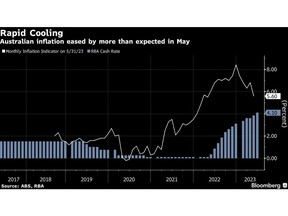Article content
(Bloomberg) — Australia’s interest rate meeting is dividing economists and money markets on whether the Reserve Bank will stand pat to assess the impact of previous tightening or raise again to forestall upside risks to prices.
Australia’s interest rate meeting is dividing economists and money markets on whether the Reserve Bank will stand pat to assess the impact of previous tightening or raise again to forestall upside risks to prices.

(Bloomberg) — Australia’s interest rate meeting is dividing economists and money markets on whether the Reserve Bank will stand pat to assess the impact of previous tightening or raise again to forestall upside risks to prices.
Story continues below
Economists are almost evenly split, with Commonwealth Bank of Australia among 14 expecting the RBA to maintain the cash rate at 4.1% on Tuesday, while 13 including Goldman Sachs Group Inc. and three other major banks forecast another quarter-point increase.
Traders are pricing a 60% chance of a pause following back-to-back hikes the RBA had described in minutes as “finely balanced” calls.
The RBA meeting comes days after the Federal Reserve’s Jerome Powell, European Central Bank’s Christine Lagarde and Bank of England’s Andrew Bailey said they still have ways to go in tamping down inflation. The US and UK have boosted rates more than Australia, while the ECB moved about as much despite a later start.
“The debate will likely be over zero or 25 basis points as the RBA deliberates on just how restrictive rates need to be,” said Su-Lin Ong, chief economist for Australia at Royal Bank of Canada. “The case for both can be made but at the margin, we think the prudent move is another 25-basis-point hike in July.”
Story continues below
Ong cited four factors that may drive a third straight month of increase:
Boosting the case for a hike, retail sales data last week surpassed expectations, highlighting households’ resilience while core inflation remains above 6%, double the top of the RBA’s 2%-3% target.
Economists also cited a renewed hawkish tilt from the RBA. Deputy Governor Michele Bullock warned last month that unemployment needs to rise to around 4.5% for inflation to return to target. The RBA also flagged the risk of price pressures becoming entrenched from a tight labor market at a time when housing shortage is driving prices higher.
Story continues below
“Capacity constraints in the housing sector imply ongoing inflation in rents and new-dwelling purchases,” said Josh Williamson, Citigroup Inc’s chief economist for Australia, who expects a hike. “The RBA would be wary of sending the wrong signal by pausing at a time when house prices are still rebounding.”
But other economists point to the RBA minutes, released weeks after each monthly meeting, as an important guide. For example, the April and May minutes were decidedly hawkish, and were followed by rate increases. In contrast, last month’s minutes were more dovish, prompting currency and bond yields to fall after their release.
The quarterly inflation report — the most comprehensive catalog of prices — comes out July 26 while the RBA staff will also deliver updated forecasts in weeks. They will provide new information for the board to consider at its August meeting and may encourage a hold on Tuesday.
Story continues below
JPMorgan Chase & Co.’s Tom Kennedy is among those who pushed back their forecast for the “next and final rate hike” to August from July. May inflation showed the smallest increase since April 2022.
Other data also point to an easing in economic momentum. Household consumption has slowed, business confidence is weakening and the probability of a recession over the next 12 months is now at 50% — the highest level since the pandemic. Economists recently trimmed their estimates for growth in the A$2.3 trillion ($1.5 trillion) economy.
“It seems that the approach of waiting for additional data before raising rates further may now be the most prudent,” said Benjamin Picton, senior macro strategist at Rabobank, citing weakening forward indicators. “We believe that Lowe will continue to aim for the soft landing.”
—With assistance from Tomoko Sato and Matthew Burgess.
Comments
Postmedia is committed to maintaining a lively but civil forum for discussion and encourage all readers to share their views on our articles. Comments may take up to an hour for moderation before appearing on the site. We ask you to keep your comments relevant and respectful. We have enabled email notifications—you will now receive an email if you receive a reply to your comment, there is an update to a comment thread you follow or if a user you follow comments. Visit our Community Guidelines for more information and details on how to adjust your email settings.
Join the Conversation